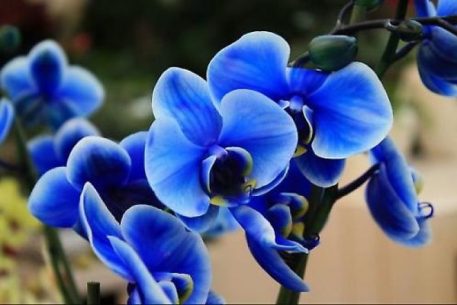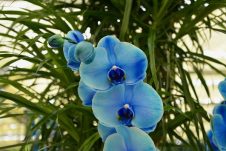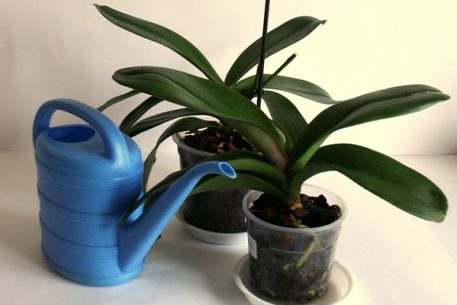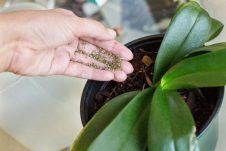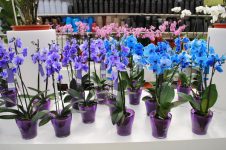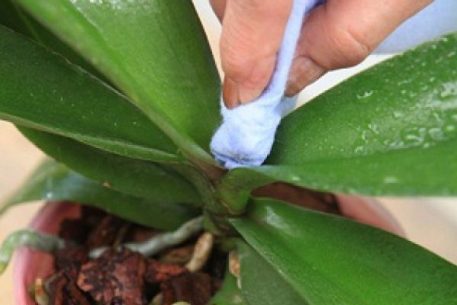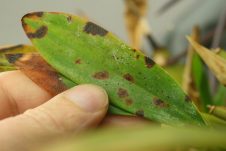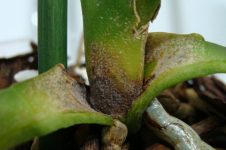Blue orchid is an unusual flower. A plant with this color recently appeared on the shelves of flower shops. But not many people know that in nature such a variety does not exist. What is the secret of the flower?
Material Content:
Blue orchid - how the miracle of nature appeared
The real miracle of nature was first presented to the general public in 2011. It happened in America (Florida) at a flower show.
The phalaenopsis plant, or in other words, the butterfly flower, was introduced by Silver Vase. Their flowers were rich in blue and looked quite unusual.
In less than 3 months, another blue beauty appeared. This happened in Holland at the annual exhibition of breeders. The flower was called the Royal Blue Phalaenopsis. There is no doubt who will win prizes in the competition.
But still you need to open a little secret.
The developers did not hide the fact that the color of the plant is not natural, but the technology of such coloring is still not disclosed. It is only known that the flower is placed in a special environment where its petals begin to darken.
Are there blue orchids in nature or are they painted
The Internet is full of beautiful photos of phalaenopsis with blue petals.
But you have to be upset, blue orchids do not occur in nature.
The plant simply does not have a gene that could color the flower in a similar pigment.
But you should not be sad ahead of time, because:
• You can purchase colored phalaenopsis.
• Choose a different type of orchid, which will have an unusual color.
The second option is the most optimal. An approximate blue color is, for example, the Vanda orchid. But she has a significant minus: the plant is very whimsical to care for. You need to have special skills so that the flower in your house takes root and begins to bloom.
Another option is the Cattleya Orchid. She is unpretentious in leaving and at the same time her flowers are very large, buds are painted in light blue tones.
What is hidden behind the coloring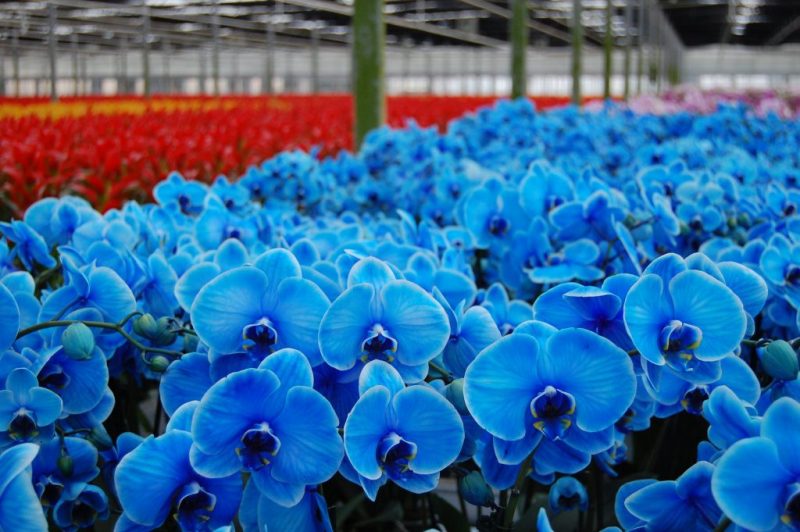
If we are talking about a blue orchid with rich pigment, then you can be sure that the flower was painted. Many sellers do not hide this information at all and openly declare it on labels.
But there are those who carefully keep secret the reason for the bright colors of the buds. As a result, acquiring a blue orchid, through one flowering, the gardener discovers that the buds have changed color, become dirty blue, with pink streaks or even white. Everything is simple - the dye is washed out, and the orchid acquires its natural shade.
Is staining harmful to the flower? Of course, because for this, chemical components are used that weaken the root system of the plant. Not surprisingly, such a phalaenopsis begins to hurt and dry.
Reaching Japanese Breeders
Blue orchid is an excellent marketing move. The unusual color of the petals is amazing, it seems that you are looking at something unusual, even cosmic.
That is why Japanese breeders are engaged in the development of "real" blue buds, not tinted ones. And in 2013, the first results of the work of scientists were already presented at an exhibition in Okinawa.
The orchid was called Royal Blue. Her petals were distinguished by a rich blue tint, and the flowers themselves were medium-sized (up to 5 cm in diameter). But at the same time on one stalk there were more than 25 pieces.
How did breeders manage to create such a miracle? As a basis, they took the usual white orchid "Aphrodite." It is unpretentious in care, reproduces well. But the blue pigment was extracted from the Asian "Commeline". Such a flower became a real miracle that man invented by applying a transgenic technique.
Of course, the plant did not get on sale. At the moment, this is a real exclusive.
What to look for before buying an orchid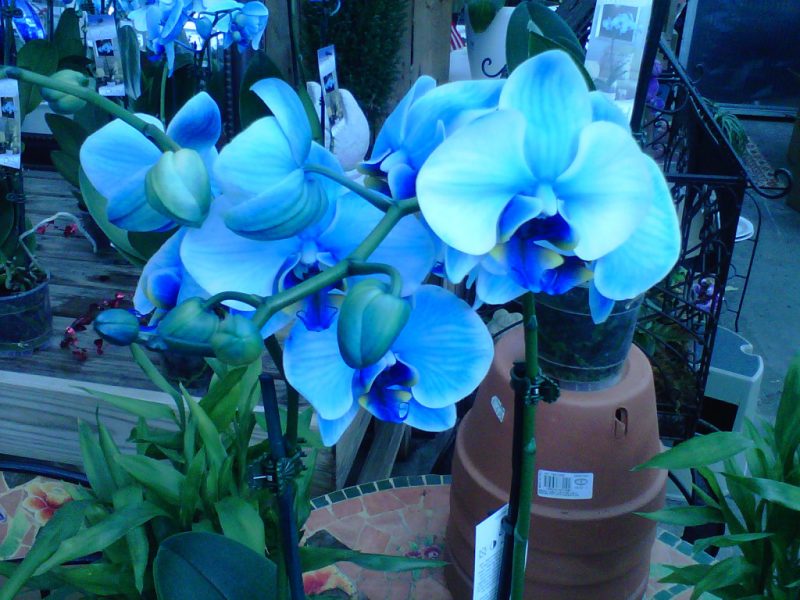
Before making a purchase, be sure to consult the seller if the orchid is colored or not. In 98% of cases you will receive a positive response.
A thorough inspection of the plant is necessary.
• You should be guarded by small punctures in the area of a root system of a flower. In this case, the dye was injected directly into the roots, which means that there is a high probability that the plant will die soon.
• There are times when traces of injections are visible on peduncles. Such a plant has a high chance of survival, given that the flower will be properly organized care.
• There is another way to achieve a blue color of the petals - to water the plant with water with a special pigment. Many use blue for these purposes. But in this case, both the stems and leaves of the plant acquire a blue color. How the plant behaves is not known.
Read also:how to care for geraniums
How to care for a flower at home
Caring for a blue orchid is as easy as looking for other species of this plant:
1. Watering. It is better to exercise it regularly. But make sure that the soil is not waterlogged. It is not worth spraying the leaves, in this case moisture accumulates, which is harmful to the leaves.
2. Feeding. In order for the plant to bloom well, it needs to be fertilized once a month. It is advisable to purchase mixtures in specialized stores.
3. The microclimate. Orchids do not like direct sunlight. Ideally, they should be scattered. The optimum daily air temperature is +25 degrees, at night + 16 degrees. There should be no drafts, the humidity level should not exceed 40%.
4. Transplant.Immediately after the purchase, you do not need to touch the flower, trying to transplant it. This will be a huge stress for the plant. It is better to do this in a year, when the orchid gets stronger.
If you notice that the plant has begun to drop petals and leaves, you need to urgently take action:
• Cut the peduncle completely. Most likely it is in it that there is a dye that is harmful to orchids.
• Inspect the roots of the flower. If there is rotten or stained, immediately remove them by making an oblique cut with a sharp knife.
• Dry the slices and be sure to sprinkle with fine ash.
• Throw out the old soil, buy a new substrate.
If these actions did not help, the orchid can no longer be saved.
It is interesting:Pelargonium: home care
Diseases and pests of the blue orchid
During flowering, a blue orchid is most vulnerable, and can be attacked by harmful insects and pathogens:
1. Ticks. A spider web appears on the plant, the leaves begin to turn yellow, dry, fall off. You can get rid of the insect with a regular soap solution or diluted ethyl alcohol. In garden shops you can buy spray products, for example, Fitoverm.
2. Worm. The creature is small, resembles a white worm. Biotrin and Mospilan help to get rid of it.
3. Rot. Small stains of brown color, similar to growths, appear on the stems and in the area of the roots. Over time, it is in these places that the plant begins to dry. The reason is improperly organized watering and increased humidity in the room. Correct actions: rinse the root system of the flower, get rid of the affected areas, replace the substrate and ensure the correct microclimate in the room.
Blue orchid is a beautiful flower. But they achieve this shade in a real barbaric way, introducing a tinting pigment into the root system of the plant. This causes stress to the orchid and in most cases it starts to hurt and dies.


